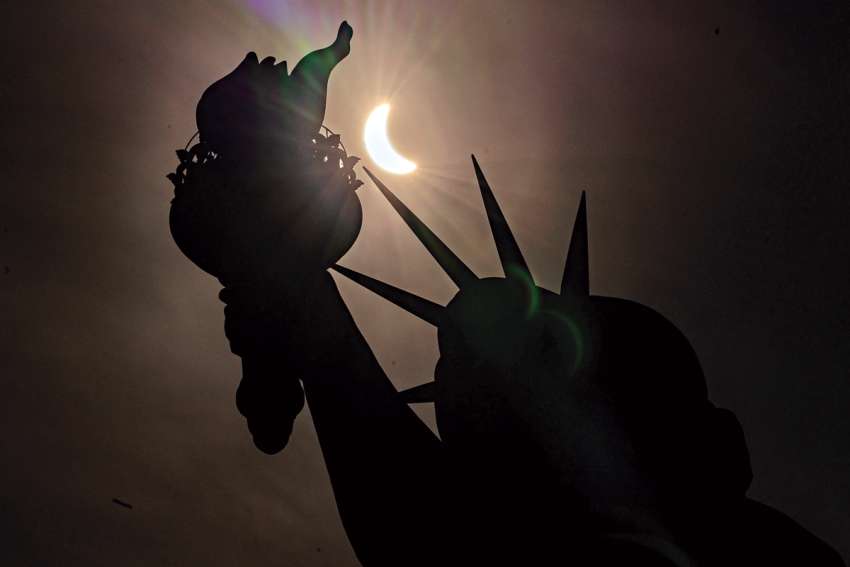For a split second the magnificence of the totality overshadowed our attachment to the science. Our spirits surrendered to the One who created such beauty, with the effect that we turned to God to depend on Him for assurance that the light would return.
We understood at the deepest level what the Catechism of the Catholic Church teaches, that “there can never be any real discrepancy between faith and reason.” Science and faith can, and do, co-exist.
Scientifically speaking, we know how the eclipse occurred. At that given moment, the orbits of the sun, moon and Earth lined up exactly so that the moon blocked the sun’s light and cast a shadow on parts of the Earth. The shadow is only about 160 km wide, increasing the rarity of being in the precise spot to witness a total eclipse.
The sun is 400 times larger than the moon, but it is also 400 times further away, making the moon and sun appear, from our perspective, to be similar in size.
But such precision, such timing, such perfection, are not arbitrary. Rather than refuting the presence of God, scientific principles that explain the mechanics of such orchestrated natural phenomena point to a Master architect who created the universe and everything in it according to His divine plan.
Science itself can neither prove nor disprove the presence of God, but what it can do is to expand our awareness of truth. The combination of information derived from empirical fact and knowledge from faith in what is unseen gives us the whole picture “because the things of the world and the things of faith derive from the same God,” says the Catechism of the Catholic Church.
“Since the same God who reveals mysteries and infuses faith has bestowed the light of reason on the human mind, God cannot deny Himself, nor can truth ever contradict truth,” it says.
Another part of the Catechism discussing science and faith explains: “These discoveries invite us to even greater admiration for the greatness of the Creator, prompting us to give Him thanks for all His works and for the understanding and wisdom He gives to scholars and researchers.”
The Catholic Church has a history of strong contributions to scientific knowledge. For instance, who developed the Big Bang Theory? Belgian diocesan priest Fr. Georges Lemaître.
Fr. Lemaître used complex mathematical models to formulate his theory that around 13.7 billion years ago, a single hot, dense point exploded, releasing a flood of matter and radiation that created particles such as neutrons, electrons and protons, atoms and other raw materials that were the building blocks for stars, planets and everything else we see in the heavens today.
In a 1933 interview with The New York Times, Fr. Lemaître said he never felt a conflict between his work as a scientist and as a priest. Science examines relatively small portions of the universe and makes deductions, he said. Religion asks questions indifferent to science: Why were planets created? Does the universe have purpose?
“I was interested in truth from the standpoint of salvation, as well as truth from the standpoint of scientific certainty,” he said. “There were two ways of arriving at the truth: I decided to follow them both.
Christian physicist and theologian Loren Haarsma points out the difference between Christian and atheist scientists lies in their interpretation and framing of the science rather than the facts themselves.
For instance, while both sets of scientists agree there is an element of randomness to many natural processes, an atheist concludes these “are fundamentally uncaused and undirected,” whereas a Christian determines “this is another means that God can use in governing the natural world,” writes Haarsma.
An atheist scientist would see parts of Scripture being disproven by science, whereas for the Christian, writes Haarsma, “Scripture helps us take scientific data and theories and fit them into a larger theological framework of God as Creator and humanity as God’s image bearers.”
Science and faith are two sides of the same coin. Let us use both as pathways leading to the God of all creation Who loves us deeply.
(Majtenyi is a public relations officer specializing in research at an Ontario university.)


